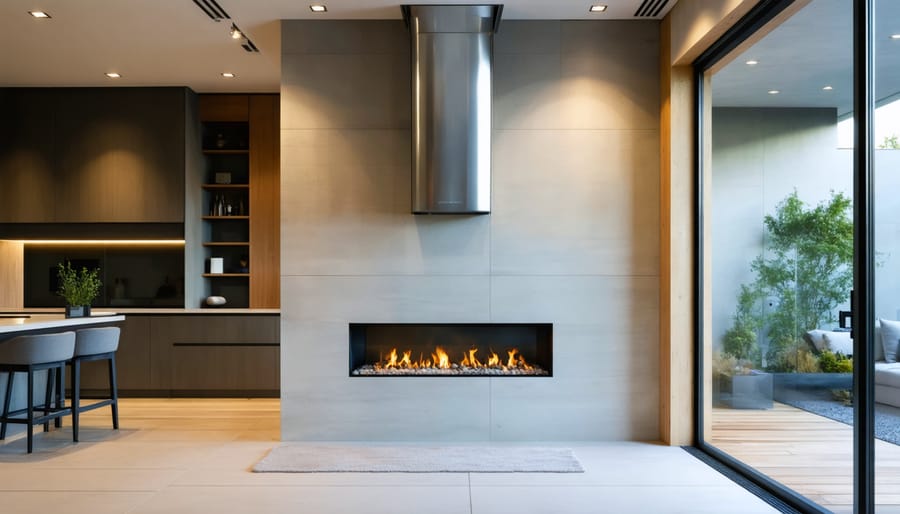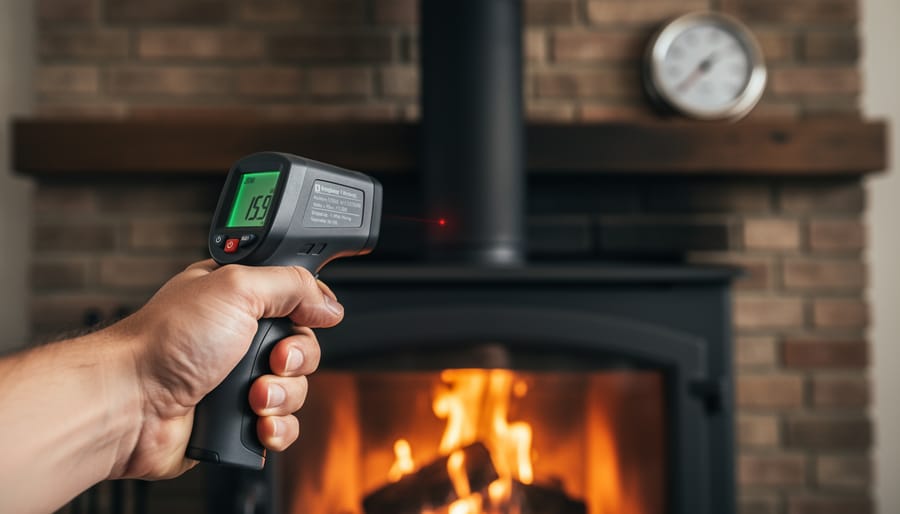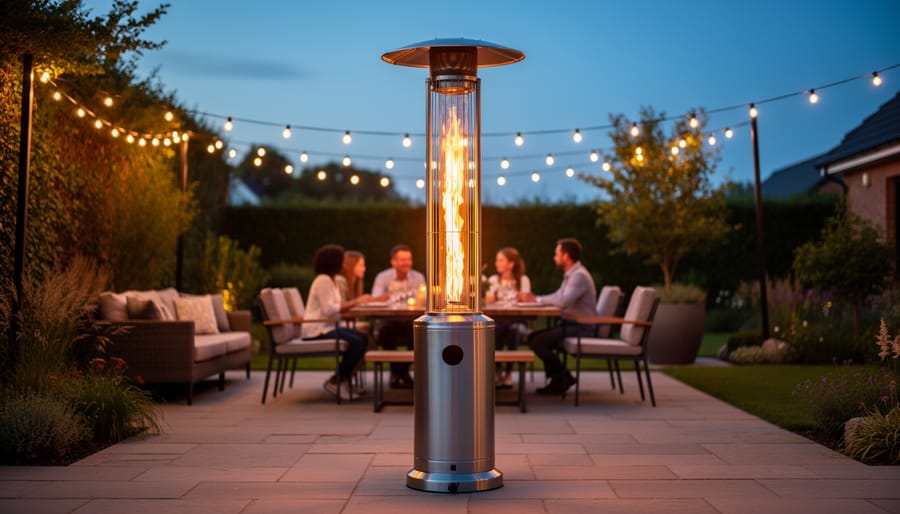Choose a 6-inch diameter pipe when your bathroom fireplace produces over 40,000 BTUs or when manufacturer specifications explicitly require it—undersizing creates dangerous carbon monoxide risks and violates building codes. Match your pipe material to your fuel type: stainless steel for gas fireplaces, double-wall for wood-burning units, and always verify clearance distances from combustible materials like wooden studs and bathroom cabinetry.
Calculate your vertical rise requirements before purchasing materials. Most 6-inch systems need a minimum of 5 feet of vertical pipe with proper termination caps, and bathroom installations often require offset elbows to navigate plumbing and electrical—each 90-degree elbow reduces your system’s efficiency and may necessitate additional vertical height to maintain proper draft.
The dream of adding a bathroom fireplace becomes reality through proper venting, yet many homeowners underestimate pipe diameter importance. A 6-inch pipe isn’t simply “bigger”—it’s a specific engineering solution for higher heat output, longer venting runs, and installations with multiple directional changes. Using inadequate pipe diameter doesn’t just reduce efficiency; it creates backdrafting hazards that push combustion gases into your bathroom, turning a luxury amenity into a safety liability.
Consider eco-friendly direct-vent models that pull combustion air from outside rather than depleting your bathroom’s oxygen. These sealed systems pair perfectly with 6-inch coaxial piping, where exhaust vents through the center while fresh air flows through the outer chamber—delivering both safety and energy efficiency while maintaining your bathroom’s spa-like ambiance without compromising air quality.
Understanding 6-Inch Fireplace Pipes in Bathroom Settings
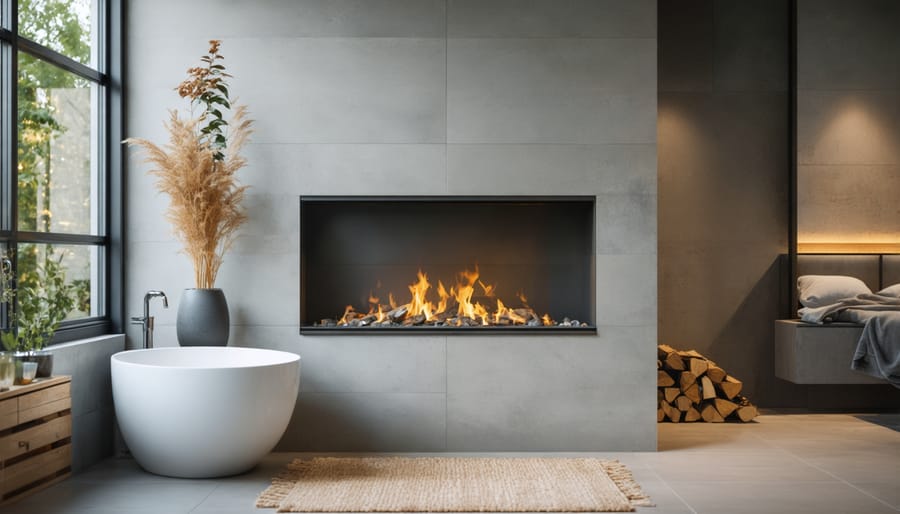
Why Size Matters: The 6-Inch Standard
The 6-inch diameter has become the gold standard for bathroom fireplace installations, and there’s solid reasoning behind this choice. Think of it as the “Goldilocks zone”—not too small, not too large, but just right for creating that cozy bathroom retreat you’re envisioning.
For most bathroom fireplaces producing between 30,000 and 60,000 BTUs, a 6-inch pipe provides optimal venting efficiency. This size allows combustion gases to exit properly while maintaining the necessary draft for safe operation. Smaller pipes can restrict airflow, potentially causing dangerous backdrafting, while larger pipes may be overkill for the space and your heating needs.
Space considerations matter too. Bathrooms typically range from 40 to 100 square feet, making a 6-inch system perfectly proportioned. It’s substantial enough to handle your fireplace’s heating output without overwhelming the room’s layout or requiring extensive structural modifications. Plus, 6-inch pipes offer excellent availability and affordability compared to custom sizes.
This standard sizing also supports eco-friendly heating by ensuring complete combustion and minimal emissions. When your venting system matches your fireplace’s requirements, you’re not just creating ambiance—you’re doing it efficiently and responsibly, keeping your bathroom sanctuary both warm and environmentally conscious.
Types of 6-Inch Pipes for Bathroom Fireplaces
When planning your bathroom fireplace, understanding the different pipe options is essential for both safety and performance. Let’s explore the three main types of 6-inch pipes and how they perform in moisture-rich environments.
**Single-wall pipes** are the most budget-friendly option, but they’re rarely ideal for bathrooms. These basic pipes lack insulation and can develop condensation issues when exposed to humid air, potentially leading to corrosion over time. They’re best reserved for short connector runs in well-ventilated spaces.
**Double-wall pipes** offer significantly better protection. With an insulated design featuring inner and outer walls, they maintain proper temperatures while preventing moisture penetration—crucial for bathroom applications. These pipes are part of the essential fireplace venting components that help your system operate efficiently in challenging conditions.
**Direct vent pipes** represent the gold standard for bathroom fireplaces. These sealed systems draw combustion air from outside while expelling exhaust, creating a completely closed loop that prevents humidity from affecting your venting system. They’re also the most eco-friendly option, maximizing efficiency while minimizing energy waste.
For most bathroom installations, direct vent or high-quality double-wall pipes provide the moisture resistance and performance you need to enjoy cozy warmth without worry.
Safety Considerations You Can’t Ignore
Humidity and Condensation Challenges
Bathrooms present unique challenges for fireplace installations due to constant moisture exposure. When warm exhaust gases flow through your 6-inch fireplace pipe and meet the humid bathroom air, condensation becomes a serious concern. This moisture can corrode standard pipes over time, compromising both safety and performance.
The key is choosing the right materials from the start. Stainless steel pipes offer excellent corrosion resistance and hold up beautifully against bathroom humidity. Many manufacturers specifically rate their pipes for high-moisture environments, so always verify these specifications before purchasing.
Consider installing a condensation drain at the base of your venting system—this simple addition catches and channels away any moisture that forms. Proper insulation around the pipe also helps maintain consistent temperatures, reducing the likelihood of condensation forming in the first place.
Regular inspections become even more critical in bathroom installations. Check for rust spots, water stains, or deterioration every few months. Remember, a well-ventilated bathroom with a quality exhaust fan will help manage overall moisture levels, protecting not just your fireplace pipe but your entire investment in creating a warm, spa-like sanctuary.

Building Codes and Clearance Requirements
Installing a fireplace in your bathroom creates a luxurious spa-like atmosphere, but it also requires careful attention to building codes that protect your home and family. These regulations exist for good reason—bathrooms present unique challenges with their combination of moisture, combustible materials, and confined spaces.
First and foremost, your 6-inch fireplace pipe must maintain proper clearances from water sources. Most building codes require at least 3 feet of separation from showers, bathtubs, and sinks to prevent water damage and ensure safe operation. This distance protects your venting system from excessive moisture that could compromise its integrity over time.
Clearances from combustible materials are equally critical. Your pipe typically needs 2 inches of space from wooden framing, drywall, and other flammable surfaces unless you’re using specially rated insulated piping. Window treatments, towel racks, and decorative wooden elements must stay well clear of both the fireplace unit and its venting system—following all safety requirements isn’t optional.
Local codes may vary significantly depending on your municipality, so always consult with your building department before starting installation. Many jurisdictions require professional installation by licensed contractors, and permits are typically mandatory for bathroom fireplace projects. These regulations aren’t bureaucratic red tape—they’re designed to ensure your cozy bathroom retreat remains safe for years to come. Working with certified professionals who understand both national standards and local requirements gives you peace of mind that your installation meets all necessary codes while supporting efficient, eco-friendly heating in your space.
Choosing the Right 6-Inch Pipe System
Matching Pipes to Your Fireplace Type
When you’re planning a bathroom fireplace, understanding how different fuel types affect your piping needs is essential for both safety and functionality. Let’s explore how each option works with 6-inch pipe systems.
**Gas fireplaces** are the most common choice for bathroom installations, and they typically require proper venting through metal pipes that can handle high temperatures. A 6-inch diameter pipe is often ideal for direct-vent gas units, which draw combustion air from outside while exhausting gases safely away from your bathroom. These systems create a sealed environment, making them perfect for moisture-prone spaces where air quality matters most.
**Bioethanol fireplaces** offer an exciting eco-friendly alternative that’s gaining popularity among environmentally conscious homeowners. The beauty of bioethanol is that it burns clean, producing primarily water vapor and minimal CO2—which means many models don’t require traditional venting pipes at all! However, you’ll still want to ensure adequate ventilation in your bathroom through existing systems, and understanding standard fireplace dimensions and specifications helps you choose the right unit size for your space.
**Ventless gas options** present another pathway, though they come with important considerations. While they don’t need exhaust pipes, they release combustion byproducts directly into your room. This makes proper bathroom ventilation absolutely critical—you’ll need excellent air circulation and possibly upgraded exhaust fans to maintain healthy air quality.
Each approach offers unique benefits, so consider your bathroom’s existing ventilation, your commitment to eco-friendly heating solutions, and local building codes when making your choice.
Material Selection: Stainless Steel vs. Galvanized
When choosing your 6-inch fireplace pipe for a bathroom installation, material selection becomes especially crucial due to the unique challenges of moisture-rich environments. Let’s explore your two primary options and what makes each one shine—or rust.
**Stainless Steel: The Premium Choice**
Stainless steel pipes are the gold standard for bathroom fireplace venting, and for good reason. This material naturally resists corrosion, even when exposed to the steam and humidity that bathrooms generate daily. You won’t need to worry about rust compromising your venting system’s integrity over time. Stainless steel also handles high temperatures exceptionally well and typically comes with longer warranties. The downside? It carries a higher upfront cost—usually 30-50% more than galvanized options. However, this investment often pays for itself through longevity and reduced maintenance needs.
**Galvanized Steel: The Budget-Friendly Alternative**
Galvanized pipes offer a more economical entry point for your bathroom fireplace project. The zinc coating provides decent corrosion protection under normal conditions. However, in humid bathroom environments, this coating can eventually wear down, potentially leading to rust and requiring earlier replacement. If you’re choosing galvanized pipe, ensure proper bathroom ventilation (think exhaust fans working overtime) to minimize moisture exposure.
**The Verdict for Bathroom Installations**
For bathroom settings, stainless steel is strongly recommended. The moisture-resistant properties align perfectly with eco-friendly heating solutions by ensuring your system operates efficiently for decades without degradation. Think of it as protecting both your home’s warmth and your long-term investment.
Installation Planning for Bathroom Fireplaces
Routing Options and Space Constraints
Installing a fireplace in your bathroom creates a luxurious spa-like retreat, but routing that 6-inch pipe through compact spaces requires thoughtful planning. Let’s explore smart solutions that keep your installation safe, functional, and beautiful.
When dealing with tight quarters, vertical routing often proves easier than horizontal runs. If your bathroom sits on an upper floor, consider running the pipe straight up through a closet or utility chase before exiting through the roof. This approach minimizes the number of elbows needed—remember, each bend reduces draft efficiency and requires additional clearance space.
Wall chases offer another elegant solution. By building out a decorative column or framing a recessed section, you can conceal your venting pipe while adding architectural interest. Just ensure you maintain the required 2-inch clearance from combustible materials like wood framing. Using insulated pipe helps reduce this clearance requirement in some cases, giving you more flexibility in cramped areas.
For bathrooms with limited vertical space, offset kits allow you to navigate around obstacles like ceiling joists or existing ductwork. These specialized fittings let you shift the pipe’s path horizontally before continuing upward—just avoid excessive offsets that could compromise draft performance.
Consider how the pipe exit affects your home’s exterior aesthetics too. A thoughtfully placed termination cap on a side wall might be less intrusive than cutting through valuable roof space, especially if you’re creating an eco-friendly heating solution that complements your home’s architectural style. Always consult local building codes, as they dictate specific routing requirements for bathroom fireplace installations.
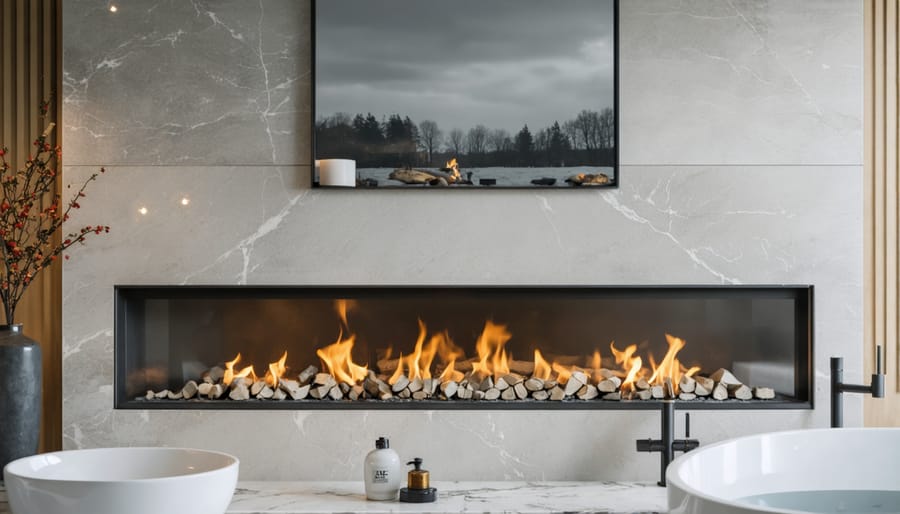
Working with Existing Bathroom Layouts
Working with an existing bathroom layout presents unique considerations compared to new construction when planning your fireplace venting system. In renovation scenarios, you’ll need to work around existing plumbing, electrical systems, and structural elements that are already in place. This often means getting creative with your venting path while maintaining safety standards.
The good news? Six-inch pipes offer flexibility that can make bathroom fireplace installations feasible even in challenging layouts. Their moderate diameter allows them to navigate through wall cavities and chase spaces more easily than larger pipes, though you’ll still need to verify adequate clearance from combustible materials.
In existing bathrooms, you may need to consider horizontal venting options if vertical runs are blocked by structural elements. This is where working with a qualified professional becomes essential—they can assess your specific layout and determine the most efficient venting route while ensuring code compliance.
New construction offers greater freedom. You can plan your venting system from the ground up, positioning your fireplace optimally and creating dedicated chase spaces. This typically results in more direct venting paths, which can improve efficiency and reduce installation costs.
Regardless of your scenario, always prioritize proper termination locations. Your vent must exit away from windows, air intakes, and other openings. In renovations, this sometimes requires adjusting your initial fireplace placement to accommodate safe venting—a small compromise that ensures your bathroom retreat remains both beautiful and safe for years to come.
Common Mistakes That Cost Homeowners Thousands
Installing a 6-inch fireplace pipe in your bathroom can transform the space into a cozy retreat, but several costly mistakes can turn your dream installation into an expensive nightmare. Understanding these pitfalls before you begin will save you thousands in repairs and potential safety hazards.
The most expensive mistake homeowners make is improper clearance from combustible materials. Many assume that because the pipe looks small, they can squeeze it closer to wooden framing or drywall than regulations allow. This creates serious fire risks and will fail inspection, requiring costly demolition and reinstallation. Always maintain the manufacturer’s specified clearances—typically two inches from combustibles for class-A chimneys.
Skimping on quality sealing products is another budget-breaker. Using incorrect high-temperature sealant or caulking meant for standard applications can deteriorate quickly, allowing dangerous gases to leak into your bathroom. This isn’t just about comfort—it’s about protecting your family from carbon monoxide exposure. Always invest in manufacturer-approved sealants rated for your specific pipe system.
Inadequate ventilation planning costs homeowners dearly when they discover their beautiful new fireplace fills the bathroom with smoke. Many forget that bathrooms have unique humidity challenges that affect draft performance. Your 6-inch pipe needs proper vertical rise and may require insulation to prevent condensation that damages your home and reduces efficiency.
Perhaps the costliest mistake is DIY installation without proper permits. While it’s tempting to save on labor costs, unpermitted work can void your home insurance, complicate future sales, and lead to mandatory removal during inspections. Professional installers understand local codes and eco-friendly installation practices that maximize your fireplace’s efficiency while keeping your family safe. When it comes to venting systems, cutting corners now means paying double later.
Maintenance and Long-Term Care
Bathrooms present unique challenges for fireplace pipe systems due to constant humidity and temperature fluctuations. To keep your 6-inch fireplace pipe performing safely and efficiently for years to come, establishing a consistent maintenance routine is essential—and it’s easier than you might think.
**Regular Inspection Schedule**
Plan to visually inspect your bathroom fireplace pipe at least twice yearly, ideally before the heating season begins and once mid-winter. Look for any signs of rust, corrosion, or moisture damage on exposed pipe sections. In humid bathroom environments, condensation can accelerate wear, so pay special attention to joints and connections where moisture tends to accumulate.
**Cleaning Requirements**
Professional chimney sweeping should occur annually, but bathroom installations may benefit from more frequent attention. Moisture can cause creosote buildup to become tackier and more stubborn. Between professional cleanings, run your bathroom exhaust fan during and after fireplace use to minimize humidity around the pipe system. This simple habit significantly extends pipe longevity while maintaining optimal draft performance.
**Humidity Management**
Consider installing a hygrometer in your bathroom to monitor moisture levels. Keeping humidity below 60% protects your fireplace pipe from premature deterioration. If you notice excessive condensation forming on or near your pipe, improving bathroom ventilation should be your first priority. This eco-friendly approach prevents costly repairs while ensuring your cozy bathroom retreat remains both safe and inviting throughout every season.
Adding a fireplace to your bathroom creates a truly luxurious retreat where you can unwind in warmth and comfort. However, the key to enjoying this lifestyle enhancement safely lies in choosing and installing the right 6-inch fireplace pipe system. As we’ve explored, proper pipe selection isn’t just about meeting code requirements—it’s about protecting your home and family while maximizing your fireplace’s efficiency and eco-friendly performance.
While this guide provides essential knowledge to help you make informed decisions, fireplace installation is rarely a DIY project. The complexity of venting systems, combined with strict safety regulations, means professional consultation is invaluable. A certified installer can assess your specific bathroom layout, recommend the best pipe materials for your heating needs, and ensure everything meets local building codes.
Think of your investment in quality 6-inch piping and professional installation as the foundation for years of cozy bathroom experiences. When done right, your bathroom fireplace becomes more than just a heating source—it transforms your daily routine into a spa-like experience while providing efficient, eco-conscious warmth. Don’t compromise on safety or quality; reach out to a qualified professional and start planning your dream bathroom retreat today.

